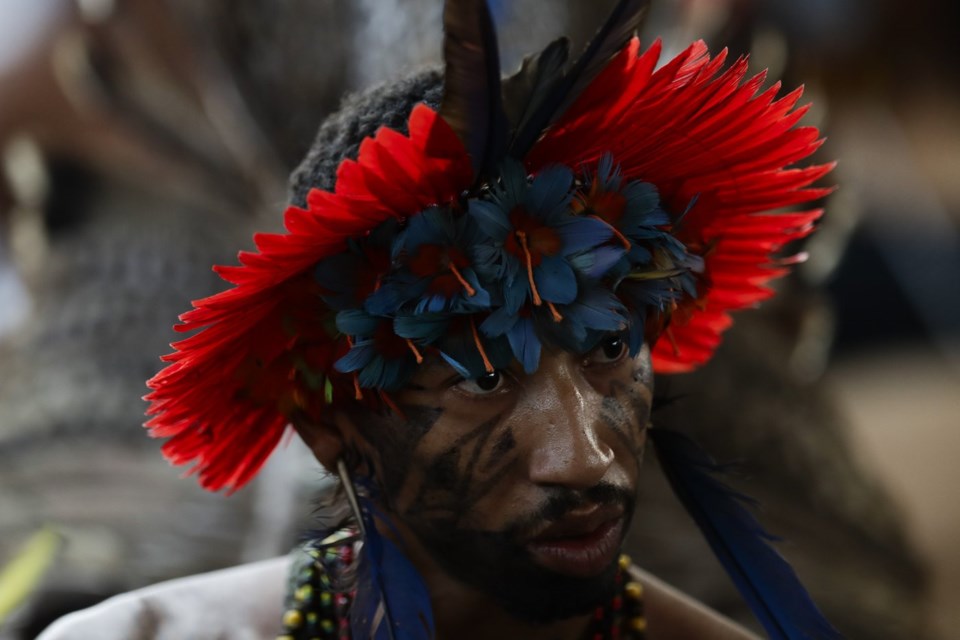RIO DE JANEIRO (AP) ŌĆö Indigenous chants and the rattle of maracas resounded Thursday in a Rio de Janeiro park, where Brazil's Tupinamb├Ī people gathered to celebrate the homecoming of a sacred cloak absent for some 380 years.
Made of feathers from the scarlet ibis, the artifact from northeastern Brazil resided in Copenhagen until the Danish National Museum donated the cloak to its Brazilian counterpart.
President and Indigenous Peoples Minister Sonia Guajajara attended a ceremony at BrazilŌĆÖs National Museum atop a hill in the Boa Vista Park.
ŌĆ£It is impossible not to appreciate the beauty and strength of this centuries-old and well-preserved piece, even after so much time outside Brazil, abroad. It is our commitment to preserve this heritage,ŌĆØ Lula said, addressing dozens of Indigenous people plus others of the general public.
Celebrations to welcome the cloak have been underway since last week. The Tupinamb├Ī traveled 28 hours overland from the northeastern state of Bahia to enter the museum where it hangs in carefully calibrated lighting and temperature conditions to ensure its preservation. There, they conducted rituals and prayers with the cloak they view as a living ancestor rather than an object.
Reconnecting with the cloak, which was once central to certain ceremonies, was "really wonderful,ŌĆØ Jamopoty Tupinamb├Ī, one of the group's leaders, said Wednesday near their encampment in the park. ŌĆ£The emotion was too much. The enchanted ones arrived, too,ŌĆØ she said, referring to spiritual ancestors.
Some at the encampment pounded drums on the parched grass amid drifting incense smoke, adorned in feathered headdresses. Anticipation and excitement due to the momentous occasion hung in the air.
The cloak stands at nearly four feet tall, and the Dutch took it from Brazil in about 1644, according to a statement from Brazil's federal government. It has been in Denmark's National Museum for 335 years, it said.
ŌĆ£In the process of colonization, he (the cloak) was taken away abruptly, violently, taking from the people what represented their greatest strength,ŌĆØ said Yakuy Tupinamb├Ī, an elder of the Indigenous group.
Centuries later, in 2000, the museum in Copenhagen lent the cloak to an exhibition in Sao Paulo. ThatŌĆÖs when JamopotyŌĆÖs mother, Amotara Tupinamb├Ī, first saw it.
ŌĆ£When she arrived there, she felt great emotion. The cloak showed her, ŌĆśI am here.ŌĆÖ ŌĆ” She was amazed,ŌĆØ Jamopoty recalled. The notion of petitioning for the cloak's permanent return was born.
Years later, Glic├®ria Tupinamba, from a village in Bahia state, traveled to Copenhagen to help identify pieces they have in their collection. The idea of securing its homecoming gathered pace.
Museums across Europe are under pressure to repatriate cultural objects. For years, on the Acropolis, which currently reside in the British Museum. French President Emmanuel Macron oversaw . Since then, France has sent little else of significance amid criticsŌĆÖ claims such moves would empty FranceŌĆÖs cherished museums.
DenmarkŌĆÖs National Museum has received three repatriation requests in the past decade, head of research Christian Sune Pedersen told The Associated Press. They responded positively to two, including that of Brazil, deciding to donate one of its five feathered cloaks partly to help rebuild BrazilŌĆÖs national museum that was ravaged by flames .
Bringing it back to Brazil was a complicated operation coordinated between the foreign affairs ministry, Brazil's embassy in Denmark, the national museums of both countries and Tupinamb├Ī leaders.
Extreme care was required to avoid damaging the delicate feathers, and its sealed box was only opened once in an air-conditioned environment, said Jo├Żo Pacheco de Oliveira, an anthropologist and curator of the National MuseumŌĆÖs ethnographic collections.
It marks the first time that an Indigenous artifact of such significance has been returned to Brazil, he said.
ŌĆ£The expectation is that this will create new possibilities for donations or even repatriation,ŌĆØ he said.
LulaŌĆÖs government took office in 2023, pledging to defend Indigenous groupsŌĆÖ land rights and established a ministry for Indigenous peoples. Such action stood in contrast to his predecessor, Jair Bolsonaro, who refused to expand Indigenous land.
However, to expel illegal miners and land-grabbers from their territories, and to establish new ones.
In a nod to their frustration, Indigenous Peoples Minister Guajajara said Thursday she wishes the number of demarcated territories were higher.
ŌĆ£We really need this number to reflect the desire of the various Indigenous peoples, who ŌĆö like the Tupinamb├Ī cloak, our relative, whose return we celebrate today ŌĆö want to return home,ŌĆØ she told the crowd.
The Tupinamb├Ī are among those asking for their land to be recognized as an Indigenous reserve and given formal protection, a process known as demarcation. BrazilŌĆÖs justice ministry is analyzing their request, according to a June statement from Brazil's Indigenous affairs agency, known as FUNAI.
The cloak's return is even more significant in that context, said Jamopoty Tupinamb├Ī.
ŌĆ£The cloak for us is the strength of the people. When he left, the people were weakened. Now he is bringing strength for the demarcation of his territory.ŌĆØ
___
AP writers Jan M. Olsen in Copenhagen, Denmark and Thomas Adamson in Paris contributed to this report.
El├®onore Hughes, The Associated Press




